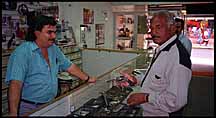 "That's why I carry a revolver in my pocket at all times, a .22 Magnum with the
same stopping power as a .357 Magnum."
"That's why I carry a revolver in my pocket at all times, a .22 Magnum with the
same stopping power as a .357 Magnum."
Central Valleyby Philip Greenspun | map |
Home : Travel : Costa Rica : One Part
Sitting next to me for the 2.5 hour flight were a siding contractor from Seattle and his wife.
"I grew up in Southern California and moved to Seattle for the relaxed lifestyle, but the pace is too much. I'm thinking of starting a bed and breakfast in Costa Rica and this trip is just to explore the place and see how we'd like it."
For someone like me who worships the air conditioner, the heat and humidity of San Jose's airport seemed stifling. I was a little afraid of taking four cameras, a pile of expensive lenses, and 70 rolls of film through customs. The official limit, apparently seldom enforced, is two cameras and six rolls of film. Because we'd had no time to plan the trip, we'd turned over the entire problem of the first week or two to a tour company and that turned out to be very helpful in the airport.
Earl, a trim smiling black man in a perfectly crisp white shirt and tie, met us in the sweltering heat and humidity of San Jose's airport. He slapped VIP stickers on our chests and shepherded us through immigration and customs in a matter of minutes. We were then in the hands of driver Jesus and "transfer guide" Alejandro. The deluxe tour companies never leave tourists alone for a minute; you always have a professional driver and an English-speaking guide even if it is just a half-hour transfer from the airport.
Alejandro was a cheerful 20 year old who knew a lot about the coffee plantations, native and imported trees, parks and buildings between the airport and the city. I asked him about his family.
"My father owns a big heavy equipment contracting business about half an hour from here. He offered me a place in the business, a house, a car, and twice what I make now, but I said forget it. He's always angry, always in a hurry and waiting for a part from the U.S."
What was life like in the small town?
"Dead. We have one McDonald's and one Pizza Hut, but no Burger King. There is nothing to do and nobody to do it with. For any excitement, we have to come back to San Jose where the discos start to fill up around 11 pm and don't empty out until the morning. Parties are wild here."
As we passed a city bus, someone threw a food wrapper out the window in our direction.
"That's what I can't stand about Costa Ricans!" Alex exclaimed. "They have no respect for the environment. Fortunately, we get very few of them on our tours so I don't have to watch them throw trash out the windows, but it is crazy."
We checked into the palatial antique-furnished Hotel Milvia, then continued downtown. San Jose is dramatically sited in the midst of cloud-covered mountains, but the pulse and pace of downtown are unnerving. Sidewalks are narrowed and crammed with pedestrians. The nation's population of 3.3 million is growing 2.7% per year and everyone seems to be moving to San Jose. Because everyone and everything is unfamiliar, it seemed much more overpowering to me than any American city other than New York.
My one American friend in the city, Alex Shaw, came to collect us and walked us over to the Holiday Inn. "Be sure that you watch your step here," Alex cautioned, "because they'll do things like leave rebar sticking right out of the sidewalk. There is no liability here for anything. If you trip, it is your funeral."
We were a little worried about eating dinner there because Alejandro had described it as "the worst hotel in Costa Rica, overpriced and ugly" [we ultimately met some tourists who stayed there and they echoed and amplified Alejandro's sentiments]. The restaurant has a fine view from the 17th floor, but it didn't open until 7 p.m. and we didn't want to hang out in the adjacent smoke-filled casino. I asked Alex if gambling were legal all over Costa Rica.
"Everything is legal here," Alex responded, "Gambling, prostitution, you name it. You just need the right government license."
We went back to the main square and passed a very elegant old house in its own garden with a Key Largo sign out front.
"That's the most famous whorehouse in Central America," Alex said. A few meters down the block he added "and this is the most famous bar in Central America. There are at least two fights there every night."
We ducked into the Hotel Amstel for a huge meal, well-prepared and competently served in an elegant dining room for about $12/person.
How did a New Englander end up here?
"It was a typical January day on Cape Cod and I was working in my chiropractic office treating patients, looking out at the cold drizzle and back at the full waiting room and I just told my secretary to `Cancel.' She said `If I cancel this afternoon, you're going to have to double up on Thursday and Friday.' `No,' I said, `I mean really cancel.' `You've got those going-to-Barbados eyes again,' she said. `I'm selling the business and you to my brother and moving to Costa Rica.' That was it."
Alex left behind a wife to whom he gave all of his worldly possessions.
"I decided that I never wanted to deal with a lawyer again, so I told her to take everything. You can't take more than 100%. I came down here with a couple of thousand dollars, the clothes on my back, and a computer. I started a bulletin board."
A bulletin board? You can't even give away bulletin board service in the States, I noted. Everyone wants Internet.
"I've got 112 subscribers. You can't bring your North American ideas down here. You've got to tropicalize them, which is how my lawyer puts it. It isn't so easy to get phone lines here, to begin with. The daughter of the minister of telecommunications has been waiting for four and a half years to get her first phone line. I've got eight lines in my house, which is unheard of in Costa Rica."
How did he do it? Bribes?
"You can't just walk into an official's office and start peeling off thousands and ask them when to stop. For one thing, they'll never tell you to stop. For another thing, it is more important who you are and who you know. That is everything in this country."
What about competition from big American companies like CompuServe? What if they move down here?
"They're already here. I am CompuServe," Alex said.
Did he have a deal with them?
"No, I registered the name here in Costa Rica. It costs $50. If they want to start operating here, they'll have to do it through me or choose another name. I'm also America OnLine, Prodigy, and GEnie."
Alex is working now on getting his cedula, or residency permit. Can you run a business without a cedula?
"Sure, but you need a Tico on your board. Let's say you want to run a charter fishing operation. First, you have to pay a higher tax than a Tico. Then when you are all set up, you can't drive the boat; you need a Tico captain."
Did he have any pangs about giving up his ties to the U.S.?
"I want to become a nonperson. I want to stop filing income tax forms. I got rid of all my credit cards and U.S. banks. I pay with cash now."
Isn't it worrisome to walk around a place that is famous for street crime with hundreds of dollars?
 "That's why I carry a revolver in my pocket at all times, a .22 Magnum with the
same stopping power as a .357 Magnum."
"That's why I carry a revolver in my pocket at all times, a .22 Magnum with the
same stopping power as a .357 Magnum."
Is that legal?
"If you have all the right permits, and I do," Alex smiled.
Has he been mugged?
"Only once in the two years I've been here. On Christmas."
Just three weeks ago? What happened?
"Two Panamanians pulled up in a car and held a .45 to my head. I saw it coming far enough in advance that I reached into my pocket. When I realized that this was the one time I didn't have my gun, I knew that the game was over. I lost $500, but I was actually lucky. The Panamanians tend to shoot their victims."
How did he know they were Panamanian?
"They were black and spoke with a characteristic Carib accent. Most of the street crime here is committed by Nicaraguans and Panamanians. Costa Rica is fairly loose about letting people in. They're supposed to leave eventually, but that doesn't mean they do."
Alex had gotten burned in a business deal with a wooden jewelry factory that promised him an exclusive New England franchise in exchange for $300,000 of business. He had the whole thing lined up with some very prestigious department stores and called back to confirm the deal.
"They'd sold $4,000 of stuff to a girl in the Peace Corps who was going to take them back to flea markets. Department stores won't touch anything if it has been in the flea markets. To understand the Tico mentality, you have to realize that the average income here is $300/month. People still feel that they are struggling to survive. If I say, `you can have this dollar now or $30,000 tomorrow,' they'll take the dollar now because tomorrow will never come. They're sure about that. That doesn't mean I don't love it here. Everything that I hate about Costa Rica is also everything that I love about Costa Rica. I hate that people take two hour lunches in the middle of a business day. But what I love about Costa Rica is that people take two hour lunches in the middle of the business day."
The Milvia seemed like an oasis after the crush of downtown San Jose. The garden, the balcony, the antiques in the lobby and the huge upstairs room with windows overlooking the city. This was Paradise, just a $1.50 10-minute cab ride from Hell.
Marco buzzed us in.
"I lived in the States for 14 years, but I've got no plans to go back. I just got married and bought a house here."
Bought a house? On a hotel night clerk's salary?
"Sure. I work four shifts a week, 12 hours each time, and earn about 45,000 colones [$271] a month. That doesn't translate into too many dollars, but our mortgage is only about 30,000 colones [$181] per month and that is for a piece of land with two houses. We rent out one for 17,000 and my wife has a good job."
What does she do?
"She's a quality supervisor for Farrah. It's an American company and they make clothes for Sears."
Would he really not consider moving back to the U.S.? Where had he lived anyway?
"Oh, near Glendale in the San Fernando Valley, you know, north LA."
That explained a lot.
"Life is much easier and better here."
Tuesday, January 17, 1995
We took a taxi downtown with Bob, a beefy Minnesotan. He'd been in the country for a couple of weeks and said that his Spanish wasn't great. When we got downtown, he asked the driver "How Mucho?"
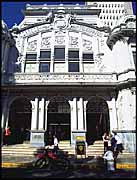
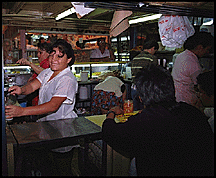 Chantal and I bought some Teva-clones from a street vendor for $9/pair and then
walked past the ornate post office to the lively Mercado Central where locals
sat at snackbars and vendors hawked produce, meat, and flowers. Then we met up
with Bobby Coto, a guide who spoke unaccented English
and wore a New York Yankees cap.
Chantal and I bought some Teva-clones from a street vendor for $9/pair and then
walked past the ornate post office to the lively Mercado Central where locals
sat at snackbars and vendors hawked produce, meat, and flowers. Then we met up
with Bobby Coto, a guide who spoke unaccented English
and wore a New York Yankees cap.
"My mother is from Pittsburgh and I attended English schools here," Bobby explained. "I really love showing people around this country. I've been doing it for about ten years. I was just about finished with my degree in business administration when the fellow I'd been working for took me aside and said `Bobby, you are not a businessman. You need to work with people. You should become a tour guide.' At the time, I was upset because I was so close to finishing my degree, but in time we became good friends and he really did me a great service."
"That's the children's museum; it used to be a prison." Bobby said. "The last administration poured money into it and opened it up. It was beautiful. Then this administration decided that it was too expensive so they closed it. It's open again now."
Did he share Alejandro's negative view of Tico tourists versus American tourists?
"Absolutely. The Tico's idea of a tour is a paseo. That's when you load a bunch of food and beer into the car and go riding around for fun; they don't go on a trip to learn something."
What about littering and throwing stuff from buses?
"You want to know how bad it is? Up until a few years ago, buses used to have signs in them `Show your education; throw trash out the window, not in the bus.' The buses, you see, are all privately owned. They are under government contract but the owners can decorate them however they want. Now there is a law that every bus must have a trash can, but old habits are hard to break."
We contemplated together the substantial amount of roadside trash.
"I haven't been on this road for a few years; the trash is a lot worse than it used to be. The local authorities are supposed to pick it up, but of course this country has many more laws than it can afford to implement. About 30% of the workforce is employed by the government; that is a tremendous burden for a country of only three million."
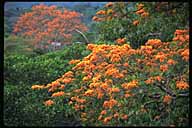 San Jose sits in the middle of the Central Valley, home to 70% of the country's
population and heavily settled and farmed. All of it is within about a
two-hour drive from San Jose. Our first stop was Alajuela, only about 20 km
northwest of San Jose. This town of 350,000 could serve as the blueprint for
any of the other towns we visited in the Central Valley. Life is centered
around a handsome public square, which features tall mango trees and a domed
bandstand. Older men and beautiful young mothers with their children fill the
square at midday. In a country where Roman Catholicism is the official
religion, it is no surprise to find a handsome church or cathedral on the
square. Given that these structures are in a tropical climate and tend to be
made of wood, it is also no surprise to find half of them under restoration.
At the other side of the square is invariably a covered bandstand for public
concerts.
San Jose sits in the middle of the Central Valley, home to 70% of the country's
population and heavily settled and farmed. All of it is within about a
two-hour drive from San Jose. Our first stop was Alajuela, only about 20 km
northwest of San Jose. This town of 350,000 could serve as the blueprint for
any of the other towns we visited in the Central Valley. Life is centered
around a handsome public square, which features tall mango trees and a domed
bandstand. Older men and beautiful young mothers with their children fill the
square at midday. In a country where Roman Catholicism is the official
religion, it is no surprise to find a handsome church or cathedral on the
square. Given that these structures are in a tropical climate and tend to be
made of wood, it is also no surprise to find half of them under restoration.
At the other side of the square is invariably a covered bandstand for public
concerts.
"There are usually three-toed sloths up in these mango trees," Bobby pointed up, "but I can't see any now."
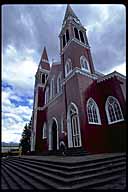 Grecia, a town 20 km west, has solved the termite problem in their church. Its
exterior is steel plates imported from Belgium in 1897. Prominent bolts hold
the thing together.
Grecia, a town 20 km west, has solved the termite problem in their church. Its
exterior is steel plates imported from Belgium in 1897. Prominent bolts hold
the thing together.
As I was walking up the steps to the entrance, Bobby grabbed me by the arm and pointed down. There was a white string stretched tightly at ankle level across the walk. In the U.S., there would have been an orange warning flag, but here you were just expected to keep your eyes open.
The wooden interior was competently executed, but what I really liked was the intricate marble altar.
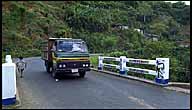 Traffic thinned out but curves got tighter as we wound up the mountain toward
Sarchí. We knew we were getting close when we saw white bridge railings
decorated with flowers and parrots. Sarchí is famous for its painted
ox-carts, just about Costa Rica's only native art form, and Bobby took us to
his favorite factory: Fábrica de Carretas Joaquín Chaverri. The
workshops here are open and we watched boys and men painting the carts. The
enamels they use are supposed to survive the elements, but I expect people who
shell out $200+ for a small cart would probably use it indoors.
Traffic thinned out but curves got tighter as we wound up the mountain toward
Sarchí. We knew we were getting close when we saw white bridge railings
decorated with flowers and parrots. Sarchí is famous for its painted
ox-carts, just about Costa Rica's only native art form, and Bobby took us to
his favorite factory: Fábrica de Carretas Joaquín Chaverri. The
workshops here are open and we watched boys and men painting the carts. The
enamels they use are supposed to survive the elements, but I expect people who
shell out $200+ for a small cart would probably use it indoors.
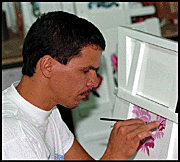
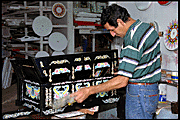
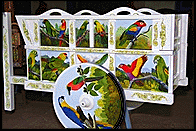
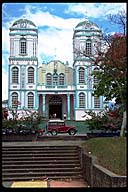
 We wound out of Sarchí and into Zarcero, a picturesque town on the
slopes of the green mountains ringing San Jose. For the past 35 years the town
has been best known for the topiary work of Evangelisto Blanco. We found him out in
the main square watering his creations, which range from a convincing elephant
to completely unexpected items like helicopters and airplanes.
We wound out of Sarchí and into Zarcero, a picturesque town on the
slopes of the green mountains ringing San Jose. For the past 35 years the town
has been best known for the topiary work of Evangelisto Blanco. We found him out in
the main square watering his creations, which range from a convincing elephant
to completely unexpected items like helicopters and airplanes.The church in back of the topiary proved worthwhile as well; the lightness of the interior decoration reminded me of the cathedral at Assisi.
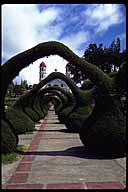
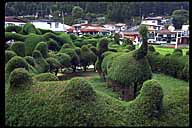
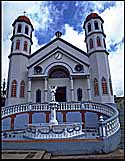
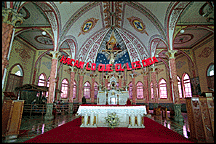
Bobby prayed silently but fervently before eating. José Manuel did not pray. When I asked people what percentage of the Catholics, who constitute 85% of the population, actually went to church, estimates ranged from 50% to 70%.
Road construction and the possibility of a two hour delay made us change our plans to exit the Central Valley. We headed west instead to the Los Angeles Cloud Forest Reserve. Long before we got to the Cloud Forest, we encountered the Cloud Road, the Cloud House, and the Cloud Farm. We couldn't see five feet in front of us. Roadside trees were indistinct.
 "Sometimes it is sunny here in the mornings," Bobby offered.
"Sometimes it is sunny here in the mornings," Bobby offered.
Costa Ricans seem to be relatively latecomers to the idea that smooth roads and road signs are worthwhile. Yet the road to the reserve and the signs to the Villa Blanca hotel in its center were excellent. You couldn't get lost if you tried.
"The hotel is owned by Rodrigo Carazo," Bobby explained. "He used to be president of Costa Rica."
When we got to the comfortable Villa Blanca, we were met cordially by Ivan Brenes, an experienced naturalist and guide at the Reserve.
"Carazo purchased all of this land, 1000 hectares [2500 acres] for about $150,000 in 1987. It is worth many times that now and he has achieved his objective, which was to show that preservation can be more profitable than destruction."
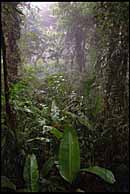 The forest was incredibly thick, dark, and wet. A constant moisture
precipitates out of the clouds and drips down from the canopy. There are
several trails in the Reserve and we elected to do the easiest, a 2 km loop
paved with wooden "cookies" cut from tree trunks. The top of each cookie is
covered in chicken wire for traction. This is how things are done at the older
Monteverde Cloud Forest Reserve and it seems to have caught on nationwide.
The forest was incredibly thick, dark, and wet. A constant moisture
precipitates out of the clouds and drips down from the canopy. There are
several trails in the Reserve and we elected to do the easiest, a 2 km loop
paved with wooden "cookies" cut from tree trunks. The top of each cookie is
covered in chicken wire for traction. This is how things are done at the older
Monteverde Cloud Forest Reserve and it seems to have caught on nationwide.
Bobby and Ivan displayed an impressive knowledge of botany and birds as we proceeded through the forest. I kicked myself for dropping out of high school, not taking biology in college, and for failing to educate myself before taking this trip. Without a basic structure in which to place the facts that Bobby and Ivan were throwing at me, I could do little but smile politely.
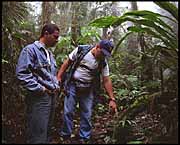 Walking out of the forest, I asked Ivan a little bit about his background.
Walking out of the forest, I asked Ivan a little bit about his background.
"I've been a guide at a whole bunch of national parks. When I was young, I worked at Manuel Antonio and it was beautiful, but it has been ruined now," Ivan shook his head in despair. "There are far too many tourists. I worked at the Monteverde Cloud Forest and now I'm 34 and living in San Ramon."
How did he like San Ramon?
"It's a wonderful town of about 55,000. When you are young, you think that a big place is good because nobody knows you, but as you get older you like to be in a place where everyone knows each other. It seems like too much work to be in a city where nobody knows or trusts each other. In a small town, people get to know you by reputation and it is easier to establish contact," Ivan continued. "Of course, it is difficult to escape a bad reputation in a small town or a small country like Costa Rica."
"Starting over and escaping your reputation and your past is a recurring theme in American literature and history," I noted.
"The best place to start over is right where you are," Ivan noted.
"If you run, you'll always be afraid of being found out," added Bobby.
Costa Rica had only 100,000 citizens at the turn of the century. Even the prodigious 2.7% growth rate and current 3.3 million population hasn't changed a culture where everyone is expected to know everyone else. As if to prove the point, a group of older Americans had just arrived and their guide was an old friend of Bobby's.
I told Bobby about our dinner last night with Alex and asked him if it was really necessary to carry a gun in San Jose.
"Well, I have a 9mm pistol for personal defense and my wife has a pistol as well," Bobby said. "San Jose can be a dangerous place."
That engendered some discussion of gun control in America and American politics.
"I think the U.S. would be better off if they had a rule like ours," Bobby said. "A president can't run for reelection the very next term. He has to wait four years and then if he did a good job people will remember and reelect him. Right now, U.S. presidents spend most of their time in the first term figuring out clever ways to get reelected."
"We were here yesterday," Beth, a tall woman from Michigan, pointing to the Basilica de Nuestra Señora de los Angeles, which is by general agreement the most impressive church in the nation. "People were crawling on their hands and knees up to a little tiny statue of La Negrita, which is the patron saint of Costa Rica. It was medieval."
"Some of these guys crawled all the way from San Jose," added Jack, Beth's husband. "Then they left whatever was most important to them in the church as an offering. There were soccer shoes and trophies and all kinds of weird stuff."
"There is also a pin board where you are supposed to put a pin in the shape of whatever part of your body the saint cured," said Beth. "There were little arms and kidneys."
We passed an eerie ruin of church walls enclosing a garden.
"They started building that, but it was damaged by an earthquake so they never finished it," said Beth. Presumably she picked that up from a guidebook, but Christopher Baker's Costa Rica Handbook (Moon) says that it was completed in 1575 and subsequently rebuilt and destroyed many times before being abandoned after the 1910 earthquake.
Baker also elaborates the story of La Negrita: "according to superstition, in 1635 a mulatto peasant girl named Juana Pereira found a small stone statute of the Virgin holding the Christ child. Twice Juana took the statue home and placed it in a box, and twice it mysteriously reappeared at the spot where it was discovered. The message in the miracle? Obviously God wanted a church built at the site."
[A Tico later explained that the people crawling to the Negrita were delivering on a contract. They would ask God for some benefit. If God delivered, they promised to crawl from wherever they lived to the Negrita. They would fulfill their promise, but only if God came through with the goods first.]
After a breakfast stop for scrambled eggs, tortillas, and gallo pinto (rice and beans) we wound up a mountainside through beautiful dairy country. We stopped in a small town to pick up Anne, an Australian on a one year walkabout, and her new boyfriend Guido, a handsome Italian law student who was on a six-week holiday in Central America.
Anne explained that she'd been converting a course for recidivist drunk drivers into a correspondence course for offenders who lived in the Outback. Did she think it was going to work?
"No. These people are brain-damaged and practically illiterate. Plus the project management was bungled and nobody had full responsibility. One person told me to take out the words `judgment' and `confident' because they were too big," said Anne.
Was she going to visit the U.S. on her trip?
"I might save that until I'm too old to ride on Guatemalan buses."
After a total of about two hours driving, we got out at a dairy farm and piled into the backs of stake trucks for a rough ride down a dirt road to the put-in. Roberto (Tico) gave us a briefing in excellent but accented English peppered freely with exclamations of "Yeee-Haw."
The briefing was pretty similar to what I'd gotten in the U.S., Australia, and New Zealand, but unlike in these Common Law countries, we were not required to sign a liability waiver.
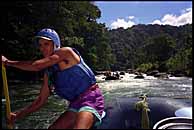 Our boat was comprised of Chantal, me, Anne, Guido, and Marta, a Tica single
mother of three. Alejandro, a young guy but not the same as the guy who
brought us from the airport, sat in the back steering. He gave us a safety
lecture in excellent English, but that turned out to be deceptive for his
conversational skills were limited. Fortunately, he and Guido could understand
each other perfectly with Guido speaking Italian and Alejandro speaking
Spanish.
Our boat was comprised of Chantal, me, Anne, Guido, and Marta, a Tica single
mother of three. Alejandro, a young guy but not the same as the guy who
brought us from the airport, sat in the back steering. He gave us a safety
lecture in excellent English, but that turned out to be deceptive for his
conversational skills were limited. Fortunately, he and Guido could understand
each other perfectly with Guido speaking Italian and Alejandro speaking
Spanish.
I'd been on about five whitewater rafting trips in different parts of the world, including Class V ("risk of death") rapids on the Tully River in Queensland, Australia. The only time I'd fallen out of the boat was when our whole raft tipped over in Australia, but it was at the bottom of a rapid and we were just swimming in flat warm water. The whole thing seemed like a joke.
The rock that pushed me up off the gunwale into the water in about two seconds wasn't joking. I couldn't breathe, I couldn't get my feet up and pointed downriver, and I hit rocks at 10-15 mph every two or three seconds. This went on for what seemed like 30 seconds but was probably closer to 15. Finally my progress was arrested by a kayak nose.
"Breathe!" shouted Roberto, "You can breathe now. Just rest on the kayak for a minute."
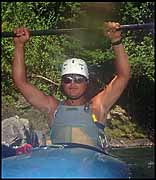 When you are in shock, your fundamental automatic processes take over; I pulled
my Nikon Action Touch out of the water and took a picture of Roberto.
When you are in shock, your fundamental automatic processes take over; I pulled
my Nikon Action Touch out of the water and took a picture of Roberto.
About a minute later, my raft had arrived past the rapid and Alejandro pulled me in.
I took up my position and my paddle more or less automatically, but I wasn't breathing normally. None of the other tourists were the least concerned about me. "Oh, he went for a little swim," seemed to be the prevailing attitude. Our raft had gotten stuck against a rock in my absence and nearly flipped over so that my boatmates didn't even imagine that my experience might have been something worthy of concern or conversation.
The river guides, however, were pretty well-acquainted with the horror of traveling underwater and bumping into rocks; each one came up to me at 15 minute intervals to ask how I was.
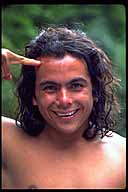 Miguel, the second kayak-based safety guide, paddling alongside and pointed to
a deep scar above his right eye. "You see, I've done it a few times myself,"
he noted.
Miguel, the second kayak-based safety guide, paddling alongside and pointed to
a deep scar above his right eye. "You see, I've done it a few times myself,"
he noted.
[It is three weeks later now and I still have a huge tender lump on my left ankle.]
I was still short of breath and the tight life jacket didn't make recovery any easier, nor did the additional rapids that made me nervously lean in toward the center of the boat. Still, I couldn't fail to appreciate that we were passing through the most beautiful jungle I'd ever seen. In terms of scenery, this was a whole different category of experience from any other rafting trip I'd been on. Enormous trees towered hundreds of feet overhead and spread their branches wide. Other trees hung down thick carpets of vines to the river. Toucans flew high across the river in pairs. Hawks circled. Kingfishers flew low across the water. Blue herons hunted fish on the banks and flew overhead.
Some combination of the enormous bump rising on my left shin, the minor bleeding wound on my right shin (which didn't hurt), miscellaneous bruises on my arms and legs, and not breathing properly, gave me a headache. Roberto kayaked over to the raft with the first aid kit and came back with some aspirin.
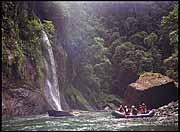 Between the aspirin and a superbly prepared and served lunch, I recovered to a
large extent. The final two hours down the river were perfect. Just as I
would start thinking that it was getting a little too hot, clouds would obscure
the sun. Just as I would start thinking that it was getting a little too cold,
we'd raft back into the sun.
Between the aspirin and a superbly prepared and served lunch, I recovered to a
large extent. The final two hours down the river were perfect. Just as I
would start thinking that it was getting a little too hot, clouds would obscure
the sun. Just as I would start thinking that it was getting a little too cold,
we'd raft back into the sun.
The scenery if anything improved on the second half of the trip. We were passing through the Pacuare Indian Reservation and Roberto pointed out some shacks on the hillside.
"An Indian family lives there," he said. "About eight people. On the two day trips we stop and hike up there. You can talk to the guys and take their pictures."
 I handed Roberto my camera and he took some photographs of us in the raft plus
paddled up next to a swimming five-foot-long boa constrictor to take its
picture.
I handed Roberto my camera and he took some photographs of us in the raft plus
paddled up next to a swimming five-foot-long boa constrictor to take its
picture.
We passed a young man waiting on the bank with a gas can who hailed Roberto. He took the empty can in his kayak and lashed it into our raft.
"That's a family who lives on the farm there," Roberto explained. "They've run out of cooking gas. It takes at least a day to walk out of the canyon so they asked me to refill this and bring it back to them on the trip tomorrow."
As we came to a spot where the river was boxed in by nearly vertical 500 foot walls, Alejandro explained that the government had planned to dam the river right here. Will they do it?
"Maybe in future," he sadly predicted.
Apparently two parts of the government have different plans for the Pacuare Gorge. In 1985, one part designated it a protected wild and scenic river. Meanwhile, the national electricity authority proceeded with its plans to dam the gorge for power.
"If we can stop the money in Washington," Miguel noted, referring to the Interamerican Bank financing, "that is the best way to stop the dam."
I asked Michael Kaye about this later.
"The dam may never be built because they aren't getting the water they need. A government minister said awhile back that the project was on hold because of the environment, but I think the real reason is economics. Impoundments in Costa Rica aren't large enough to store water from the wet into the dry seasons. They therefore need water year-round to make the project economic. We've been rafting this river for years and the level right now is lower than it normally is by the end of the dry season."
What has changed?
"Deforestation in the watershed. The forest acts as a buffer and holds a lot of water. The worst thing is that people are deforesting the shed for subsistence farms. It works great for a year or two because the soil is incredibly rich, but it burns out quickly and they have to move on and deforest some more land. The only that might be happening on the Pacuare is a dam upriver from where you rafted."
I thought the land around the Pacuare was protected from deforestation.
"It is. So is the reserve around Corcovado. It has been 50% deforested since they designated it protected. That doesn't mean the protection is completely ineffective. It might have been 85% deforested if it hadn't been protected."